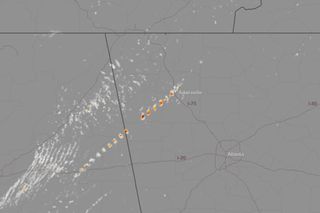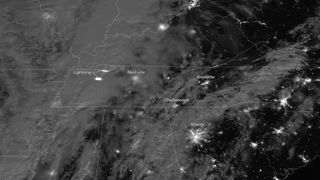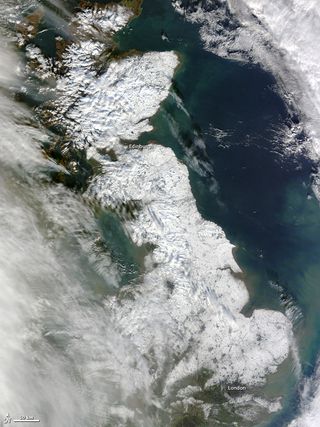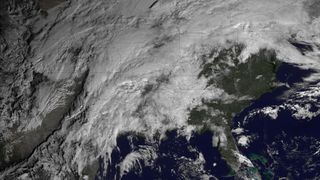
Best Earth Images of the Week Feb. 2, 2013
A new start

Each year after the breeding season ends, male reindeer shed their impressive, branching antlers that they grow. Lenni, the six-year-old European forest reindeer at Scotland's Highland Wildlife Park, shed quite a set of antlers this year.
Lenni's antlers weighed in at a combined 23 pounds (10.5 kilograms), about the same as a 1-year-old child, the park noted in a release. Each antler was 37 inches (94 centimeters) tall and 31.5 inches (80 cm) wide.
[Full Story: What a Reindeer Looks Like Without His Antlers]
Powerful twister

A powerful tornado bore down on the town of Adairsville in northwest Georgia earlier today (Jan. 30), as part of a long line of severe weather stretching from Pittsburgh, Pa., to the Gulf Coast. The signature of the tornado's rotating winds can be seen in a newly released radar image.
The National Severe Storms Laboratory, run by the National Oceanic and Atmospheric Administration, did an experimental analysis of their NEXRAD radar, which showed "high rotational velocity" that was consistent with a tornado, according to a NOAA statement. The signature can be seen moving from Alabama across the border into Georgia, matching up with storms by the NOAA Storm Prediction Center.
[Full Story: Georgia Tornado Signature Revealed in Radar]
Lightning flashes

A line of severe storms, reaching from Pittsburgh to the Gulf Coast, is currently sweeping its way across the eastern United States. The system started rolling through the mid-South and parts of the Midwest yesterday (Jan. 29), and a satellite snapped a nighttime view of a lightning flash generated by the storms.
The Suomi NPP satellite, run jointly by NASA and the National Oceanic and Atmospheric Administration, flew over the satellite activity last night. Because of the near-full moon, the satellite was able to see details of the storm clouds that would only be visible during daylight hours to other satellites, according to a NOAA statement.
[Full Story: Lightning Flash from Severe Storms Seen from Space]
Prepare for the punch

Tropical Cyclone Felleng, currently spiraling off the east coast of the island of Madagascar, was caught in a NASA satellite image exhibiting "overshooting cloud tops," a clear sign that it is packing powerful storms.
A NASA statement describes an overshooting cloud top as a domelike protrusion that balloons out from the anvil head of thunderstorm cloud and shoots up into the stratosphere, the layer of the atmosphere above the troposphere. The troposphere is where most weather on Earth occurs.
[Full Story: Cyclone's 'Overshooting Cloud Tops' Seen from Above]
Snow shroud

Unusually frigid and snowy conditions blanketed much of the island of Great Britain in snow earlier this month. The winter wonderland was spotted from above by NASA's Terra satellite on Jan. 26.
The snow started falling mid-month when a storm system blowing in from over the North Atlantic combined with unusually chilly conditions ushered in by a pattern called the Scandinavian Block, according to Accuweather.com. This high-pressure pattern sits in place over Scandinavia and funnels cold air toward the United Kingdom from over the Baltic and western Russia, according to the U.K. Met Office.
[Full Story: Britain Blanketed by Snow in New Satellite Image]
Warning of what's to come

After an Arctic blast left much of the United States out in the cold, a new system is bringing the threat of severe weather to the central portions of the country this evening and through the night. A satellite snapped an image of the system earlier this morning (Jan. 29).,br>
The National Weather Service's (NWS) Storm Prediction Center, located in Norman, Okla., has forecast severe thunderstorms, with damaging winds and hail and possibly even tornadoes for the lower Ohio Valley, the mid-South and the lower Mississippi Valley. The SPC says the threat will increase through the night, with squall lines (or long lines of thunderstorms) and individual storms rolling through along with a cold front.
[Full Story: Satellite Spies Severe Weather Brewing]
Sign up for the Live Science daily newsletter now
Get the world’s most fascinating discoveries delivered straight to your inbox.











